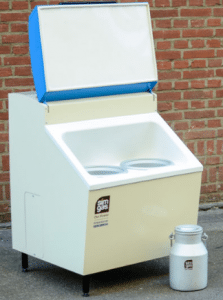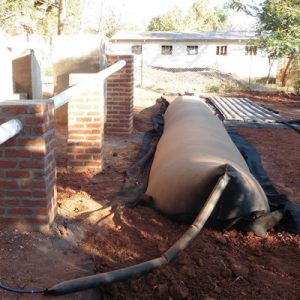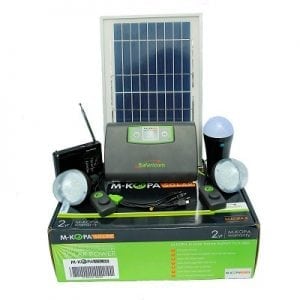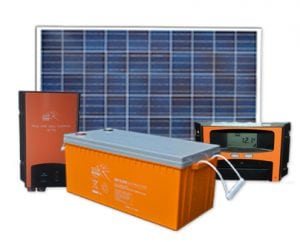
Agriculture
February 26, 2024
SimGas Biogas Milk Chiller
Read SolutionImplemented by
SimGas

Updated on December 18, 2024
·Created on August 27, 2015
The GesiShamba is a modular fixed dome biogas system developed to use recycled waste from rural farms and households.
The GesiShamba is a modular fixed dome biogas system developed by SimGas for rural households. The system provides energy from recycled waste and produces a bio-fertilizer slurry for farms and gardens, the system can also be used for co-digestion of biodegradable materials.
Target SDGs
SDG 7: Affordable and Clean Energy
SDG 8: Decent Work and Economic Growth
Market Suggested Retail Price
$1,200.00
Target Users (Target Impact Group)
Household, Community
Distributors / Implementing Organizations
SimGas and their partner Silafrica Tanzania Ltd.
Competitive Landscape
Direct competitors include Sistema Biobolsa, Flexi Biogas BG5, ADRA Cold Climate Biodigester, and ARTI Biogas Plant.
Regions
Africa
Manufacturing/Building Method
Mass produced between SimGas's two production sites located in Tanzania and Kenya.
Intellectural Property Type
Patent
User Provision Model
The GesiShamba can be purchased from SimGas and third-party vendors. The system is delivered and installed by the company's technicians. The company seeks retailers and provides information on how to partner with them.
Distributions to Date Status
The SimGas Biogas Program with the Gold Standard expected to distribute 10,000 systems throught Kenya. The company expects to install 30,000 systems per year by 2020.
Output energy product
Unknown
Average daily biogas production (m3/day)
Unknown
Description of waste source(s)
Human, animal, and organic waste
Waste input requirements (kg per hour or day)
Unknown
Description of other input requirements
Unknown
Other input requirements (amount per hour)
Unknown
System dimensions (m)
Unknown
Design Specifications
The fixed dome digestor modular with volumes ranging from 2 m3 to 20 m3. Weight begins at 20kg. For its construction high density polyethylene which represents a post-consumer plastic, is necessary to obtain injection- moulded components and extruded seals.
Technical Support
Provided by SimGas representatives through "after-sales service" and detailed user-training.
Replacement Components
Available.
Lifecycle
2 year warranty. Lifespan of at least 20 years.
Manufacturer Specified Performance Parameters
Manufacturers specify that the GesiShamba is an easy transportable system (100 kg with nested parts), high production outcomes of about 40%, and excellent slurry (bio-fertilizer) production.
Vetted Performance Status
A case study developed by South and East Africa Energy and Environmental Partnership (EEP) identified that users save $636 USD per year on fuel costs per household, users can generate $408 USD per year per household, by using the bio slurry households experience up to a 200% increase in crop revenues, users can save about 1.5 hours per day when going from making a fire to switching on a biogas stove in a matter of seconds, a reduction on emissions by by 8.2 tonnes CO 2-eq per year per household can be achieved and the usage of the systems could prevent deforestation by reducing consumption of 7.42 ton wood/charcoal per year per household.
Safety
There are some dangers associated with biogas digesters: fire hazard, leaks and negative pressure, but since this is a small/ family size system the hazards are also lower.
Complementary Technical Systems
None.
Academic Research and References
Vogeli, Y., Lohri, C.R., Gallardo, A., Diener, S., Zurbrugg, C., Anaerobic digestion of biowaste in developing countries: practical information and case studies. Laufenburg, Switzerland: Swiss Agency for Development and Cooperation SDC; 2014 [cited 20 Jul 2015].
Castro, Mirik , Samuel Castro, and Chandler Elizabeth Hatton. 2012. Biogas System, issued June 2012.
SimGas.org. n.d. www.facebook.com.
CDM: SimGas Biogas Programme of Activities. n.d. cdm.unfccc.int.
CDM: Biogas/Biomass Thermal Applications for Households/Small Users — Version 4.0. n.d. cdm.unfccc.int.
CDM: Methane Recovery in Agricultural Activities at Household/Small Farm Level — Version 3.0. n.d. cdm.unfccc.int.
CDM: Switch from Non-Renewable Biomass for Thermal Applications by the User — Version 13.0. n.d. cdm.unfccc.int.
Compliance with regulations
Complies with all relevant UNFCC requirements for the Clean Development Mechanism.
Evaluation methods
Baseline and monitoring methodologies:
Other Information
SimGas also offer other companion products like: stoves, commercial burners, and biogas rice cookers.

Agriculture
February 26, 2024
Implemented by
SimGas

Agriculture
January 24, 2024
Implemented by
Bornay

Agriculture
January 20, 2024
Implemented by
Sustainable OneWorld Technologies C.I.C. (SOWTech)

Agriculture
December 7, 2024
Implemented by
M-KOPA

Agriculture
June 23, 2024
Implemented by
Gogoro Inc.

Agriculture
December 11, 2024
Implemented by
Sun King

Agriculture
December 11, 2024
Implemented by
SolarNow

Agriculture
December 30, 2023
Implemented by
Schneider Electric Industries SAS

Agriculture
June 20, 2024
Implemented by
Electric Vehicle Association of Thailand (EVAT)

Agriculture
December 23, 2024
Implemented by
Guangzhou Anern Energy Technology Co., Ltd
Have thoughts on how we can improve?
Give Us Feedback